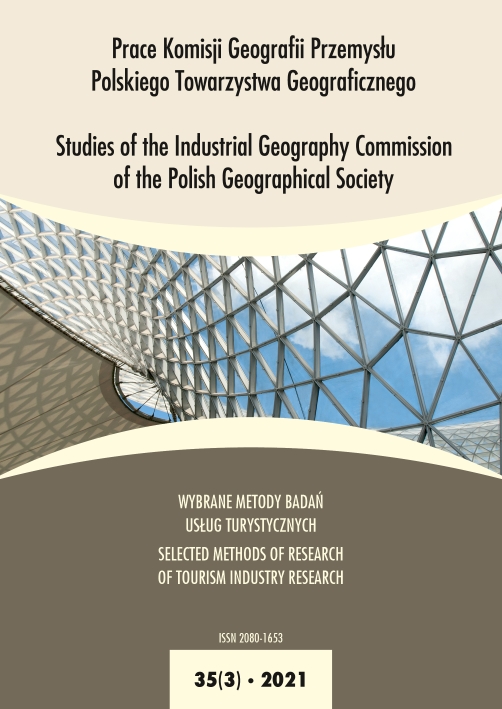Contemporary use and social importance of the post-industrial heritage in the Kamienna river valley (Poland)
DOI:
https://doi.org/10.24917/20801653.353.13Keywords:
Central Industrial District, conditions for industrial development, industrial heritage, Kamienna river valley, Old Polish Industrial DistrictAbstract
The aim of the article is to identify the industrial heritage located in the valley of the Kamienna river (Poland), and in particular to examine its current use and the importance it plays in the minds of the inhabitants of the communes included in the studied area. The empirical basis of the study was the research carried out in the period from July to September 2019, consisting of both participant observation, field inventory and a questionnaire interview conducted with the inhabitants of the studied communes. The collected material revealed that this area, despite the passage of years, has a rich and unique post-industrial potential in Poland, which is a testimony to its rich and long history. Although today the importance of the industrial function in the Kamienna valley is much smaller, the legacy preserved there has enormous economic, cultural and social potential. Currently, however, its capabilities are not fully used, mainly due to the human factor.
Downloads
Metrics
References
Fierla, I. (1979). Geografia przemysłu Polski. Warszawa: Państwowe Wydawnictwo Ekonomiczne.
Furtak, M. (2014). Centralny Okręg Przemysłowy 1936–1939. Architektura i urbanistyka. Kraków; Łódź: Dom Wydawniczy Księży Młyn.
Gołębiowski, J. (2000). COP – dzieje industrializacji w rejonie bezpieczeństwa 1922–1939. Kraków: Wydawnictwo Naukowe Akademii Pedagogicznej.
Guldon, Z. (1994). Górnictwo i hutnictwo w Staropolskim Zagłębiu Przemysłowym w II połowie XVIII wieku. Kielce: Towarzystwo Przyjaciół Górnictwa, Hutnictwa i Przemysłu Staropolskiego.
Jędrysiak, T. (2011). Turystyka kulturowa w obiektach poprzemysłowych – zagadnienia ogólne. Turystyka Kulturowa, 6, 207–228.
Kaczmarska, A., Przybyłek, A. (2010). Wykorzystanie potencjału przemysłowego i poprzemysłowego na potrzeby turystyki. Przykład Szlaku Zabytków Techniki województwa śląskiego. W: W. Andrejczuk (red.), Krajobraz a turystyka. Sosnowiec: Komisja Krajobrazu Kulturowego PTG, 17–35 (Prace Komisji Krajobrazu Kulturowego, 14).
Kasprzyk, B. (2012). Milica 1950–1955. Historia pierwszego powojennego osiedla w SkarżyskuKamiennej. Skarżysko-Kamienna: Muzeum im. Orła Białego.
Koźmiński, K. (1955). Zagłębie Staropolskie w kieleckiem. Warszawa: Sport i Turystyka.
Kronenberg, M. (2012). Wpływ zasobów dziedzictwa przemysłowego na atrakcyjność turystyczną miasta. Przykład Łodzi. Łódź: Wydawnictwo Uniwersytetu Łódzkiego.
Nowakowska, A., Walczak, B. (2016). Dziedzictwo przemysłowe jako kapitał terytorialny. Przykład Łodzi. Gospodarka w Praktyce i Teorii, 45(4), 45–56. doi: http://dx.doi.org/10.18778/14293730.45.04.
Osiński, J. (1782). Opisanie polskich żelaza fabryk […]. Warszawa: w Drukarni J.K.Mci i Rzeczypospolitey u XX. Scholarum Piarum.
Pazdur, J. (1959). Działalność Stanisława Staszica w Kielecczyźnie. Kielce; Kraków: Kieleckie Towarzystwo Naukowe.
Przazga, S. (1969). Rozwój społeczno-gospodarczy Staropolskiego Okręgu Przemysłowego w latach 1960–1968. Kielce: Wojewódzki Urząd Statystyczny.
Pyzik, Z.W. (1996). Prahistoria Rydna. W: Z pradziejów regionu świętokrzyskiego. Kielce: Muzeum Narodowe.
Rakowski, J. (1938). Rola Centralnego Okręgu Przemysłowego. Warszawa: Nakładem Tygodnika „Polska Gospodarcza”.
Wrzosek, A. (1972). Główne okręgi przemysłowe Polski. Warszawa: Państwowe Zakłady Wydawnictw Szkolnych.
Zieliński, J. (1965). Staropolskie Zagłębie Przemysłowe. Wrocław: Zakład Narodowy im. Ossolińskich.
Downloads
Published
How to Cite
Issue
Section
License

This work is licensed under a Creative Commons Attribution-NoDerivatives 4.0 International License.
Articles are published under the terms of the Creative Commons License (CC BY-ND 4.0; Attribution– NoDerivs).

